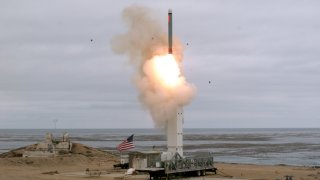Can U.S. Missile Defenses Handle the Weapons of Tomorrow?
A principal challenge, many maintain, will be the need to establish a continuous sensor track as faster space-traveling weapons and hypersonics will present as-of-yet unprecedented threats.
Here's What You Need to Remember: Hypersonic weapons, some of which can travel through space at five times the speed of sound, are nearly impossible to track, a reality inspiring the MDA’s current command and control sensor strategy. Instead of merely needing to send stovepiped or disaggregated radar detection systems, there is a need to network radar and satellite systems together to establish a “continuous track” of an approaching weapon, without having to pool segregated radar feeds.
Missile Defense in 2030 will require hypersonic defenses, new intercontinental ballistic missile (ICBM) interceptors, upgraded satellites, advanced radar and, most of all, an advanced “kill web” of integrated sensors to track approaching enemy missiles and transmit crucial, time-sensitive information.
“If the adversary launches at us, we’re going to the joint kill web [to] enable us to censor any sensor by shooter to engage,” Army Lieutenant General Daniel L. Karbler, commander of the Army Space and Missile Defense Command, said in a Pentagon report.
A principal challenge, many maintain, will be the need to establish a continuous sensor track as faster space-traveling weapons and hypersonics will present as-of-yet unprecedented threats.
“When you look at 2030, we’re looking at advanced ballistic missiles, [and] we know they’re going to maneuver hypersonic threats and cruise missile threats. That’s a very challenging place to be.” Navy Vice Admiral Jon A. Hill, director of the Missile Defense Agency (MDA), said in the Pentagon report.
The approach, the senior leaders explained, involves a mix of Army-fired ground missile defenses to take out enemy rockets, ballistic missiles and other inside-the-atmosphere threats. For ICBM defense, Hill talked about a two-fold trajectory, including maintaining the existing Ground Based Interceptors through upgrades and sustainment efforts, such as the Next-Generation Interceptor.
When you get into ground-based missile defense or midcourse defense for protection of the United States, we are working very intensely on the service-life extension program, along with the reliability program that takes us beyond just the analytical,” Hill said.
The basis for the Next Generation Interceptor, Missile Defense Agency developers explain, hinges upon sensor networking. This weapon, perhaps even more than others, will need the advanced “kill-web” network of meshed sensors to track and destroy an entirely new generation of threats.
Hypersonic weapons, some of which can travel through space at five times the speed of sound, are nearly impossible to track, a reality inspiring the MDA’s current command and control sensor strategy. Instead of merely needing to send stovepiped or disaggregated radar detection systems, there is a need to network radar and satellite systems together to establish a “continuous track” of an approaching weapon, without having to pool segregated radar feeds.
“While we have to also compete in parallel with the next generation interceptor… by closing that gap with a very strong liability program for the fleet today, and bringing on a new interceptor that will tie into the ground systems and into the sensors, [it] is going to be pretty formidable,” Hill said.
Kris Osborn is the new Defense Editor for the National Interest. Osborn previously served at the Pentagon as a Highly Qualified Expert with the Office of the Assistant Secretary of the Army—Acquisition, Logistics & Technology. Osborn has also worked as an anchor and on-air military specialist at national TV networks. He has appeared as a guest military expert on Fox News, MSNBC, The Military Channel, and The History Channel. He also has a Masters Degree in Comparative Literature from Columbia University. This first appeared earlier and is being reposted due to reader interest.
Image: Reuters.

